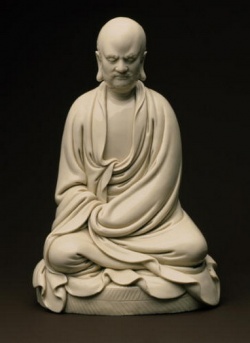Dosho
Dosho
道昭 (629–700)
A priest of Japan who first introduced the Dharma Characteristics (Hosso) school to his country. A native of Kawachi Province, he entered the priesthood at Gango-ji temple in Nara. In 653 he went to China, where he studied the Dharma Characteristics doctrine under Hsüan-tsang and the Zen teachings under Hui-man. After an eight-year period of study in China, he returned to Japan and introduced the Dharma Characteristics doctrine. This is regarded as the first transmission of the Dharma Characteristics doctrine to Japan. He also traveled to many provinces to propagate the Dharma Characteristics teaching. He built a meditation hall at Gango-ji, where he preserved the Buddhist scriptures he had brought from China. In 698 he was appointed general supervisor of priests. After his death, his body was cremated according to his instructions; this is considered the first case of cremation in Japan.
Dōshō (道昭?, 629–700 C.E.) was a Japanese monk credited with playing an influential role in the founding of Buddhism in Japan. In C.E. 653, he travelled to China, studying under the Buddhist monk Xuanzang, whose travels to India were immortalized in the book Journey to the West. His studies centered on Xuanzang's Weishi, Chinese variant of Indian Yogācāra, but he was also exposed to Chinese Chán while there, which would later lead to his influence on the founding of Japanese Zen Buddhism. In China, the school is known as Wéishí-zōng (唯識宗, "Consciousness Only" school), or Fǎxiàng-zōng (法相宗, "Dharma Characteristics" school). In Japan, it is known as Hossō-shū (法相宗?) or Yuishiki-shū (唯識宗?).
After returning from China, Dōshō became a priest at Gangō-ji, one of the great temples, the Nanto Shichi Daiji, in Nara, Japan. His teachings were based on the consciousness-only philosophy taught by Xuanzang, which in Japanese he called Hossō. It was at Gangō-ji that later he founded Japan's first meditation hall.
There is a legend about his return from China that says Xuanzang had given him a magical kettle. Whenever any medicine was prepared in the kettle, it could cure any illness. The monk traveling with Dōshō was supposedly cured before embarking on the sea trip back to Japan. However, while at sea a great storm came upon them. A diviner on board said that the sea god wanted the kettle. Dōshō at first resisted, but eventually gave in, and the storm immediately abated.
